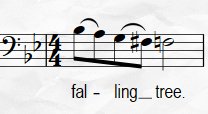Computer programmes and video games often include Easter eggs – little intentional secrets, inside messages or secrets to be found by the users and players. I’ve always thought of word painting (in the musical sense!) somewhat in the same way.
When related to text, word painting is all about the use of highly descriptive words to invoke images into the reader’s mind. Musical word painting is the equivalent using notes – Grove Music defines it as “The use of musical gesture(s) in a work with an actual or implied text to reflect, often pictorially, the literal or figurative meaning of a word or phrase”. It can be found across the musical spectrum, though commonly in Renaissance and Baroque music, art songs (aha!) and folk music such as madrigals. Sometimes a motif representing a mood – e.g. grief – may be the basis a whole piece revolves around, and in others it can be a fleeting gesture supporting the text.
Some musicians, composers and musicologists shy away from word painting, thinking of it as a bit childish and simplistic. However, I personally think of it more as human nature. Think of a sentence with the word “falling” in it. Say it out loud a few times. Does your intonation rise or fall on that word? It seems to me it falls the majority of the time when I say it – or am I just word painting with my speech too? (I’ve always waxed lyrical about how musical speech is!).
I like adding in moments of word painting. I particularly like a phrase where you have a melody established (and potentially expected), and then it varies just slightly because of some decorative word painting. Sometimes listeners pick up on it and sometimes not, but performers (and musicologists!) do. I adore musical analysis, and that side of me loves finding a bit of surreptitious word painting in a piece – so it’s only natural I include some in my own music!
Here are a handful of word painting moments from Cracked Voices art songs (so far!). It’s only a brief selection of four – how many more will there be by the time the cycle is complete? All snippets below are taken from the vocal lines.

From The devil and the draper – a bit of hopping to begin the chorus! The melody hops up a third then another third, with bouncy staccatos in a rather quirky, bouncy time signature (7 8 being a personal favourite).

From Three riddles (no.2) – A falling tree.

From Those who wait – shards are spiky staccatos (may turn into staccatissimos, or accented staccatos in the final version) to demonstrate their sharpness. The intervals between the words -voke, you, with and shards are all diminished fourths – a dissonant interval, uncomfortable to sing and commonly referred to as the devil’s interval.

The final excerpt is also from Three riddles (no.2) – an earthquake rocking the baritone’s line. Rock this place begins the rocking motion in triplets, followed a couple of bars later by a continuation of the rocking (yet downwards) motion.
Musical Easter eggs anyone?
